Chapter 5 Charting Vowels
Charting Vowels 母音圖表
Formats One and Two 第一及第二共振峰
The
vowels of a particular speaker can be described precisely by stating their
formant frequencies. People with larger resonating cavities will produce
formats with comparatively low frequencies, and others will have higher
formant frequencies because they have smaller vocal folds.
The
most useful representation of the vowels of a language is a plot showing
the average values of format one and format two for each vowel as spoken
by a group of speakers.
藉由描述母音共振峰的頻率可以知道該母音是由某個特定的人所發出。有較大的共鳴腔的人,其發音的共振峰會有較低的頻率;有較高共振峰頻率的人,則是因為他們的聲帶較小。
See
the figures below. The first formant has a low pitch for i (heed),
a high pitch for a (hod), and a low pitch for u (who’d)
which is the opposite of what the tongue does (high in heed, low in
hod, and high in who’d)
The
second formant is hign for i (heed) and low for u (who’d).
The tongue is in front of the mouth for i (heed) and towards
the back for u (who’d), but the vowel in which the tongue
is furthest back in the mouth is a (hod). It is apparent
that the frequency of the second formant is related to something else as
well as tongue position. The major part of the lowering of the second
formant is due to the increase in lip rounding.
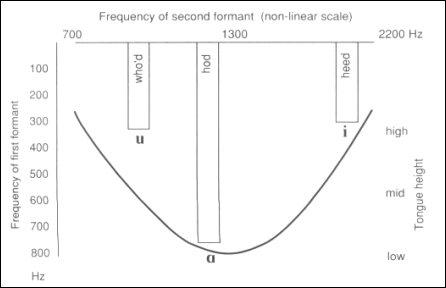
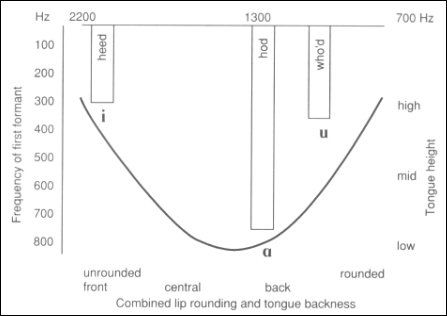
第一共振峰的呈現與舌頭的位置正好相反。第二共振峰的影響因素在於圓唇的程度。
In
the figure below, the bars for each vowel have been replaced by points.
This kind of representation of vowels is known as a formant chart.
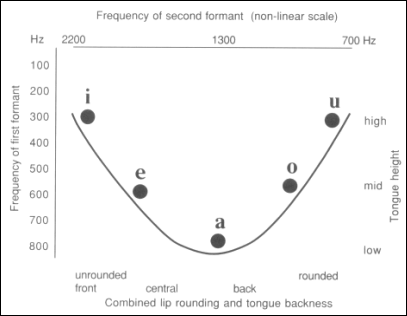
Comparing English Vowels 英語母音的比較
In the figure below, the vowels in bay and bow are indicated by lines, to show that these vowels are diphthongs, starting with one vowel quality and ending with another.
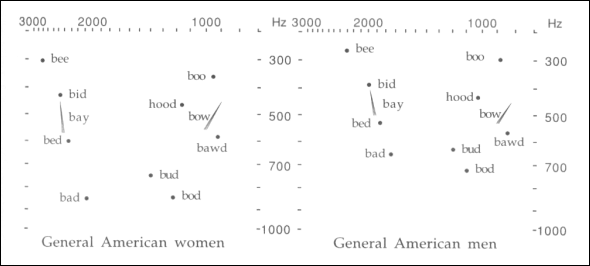
One
thing to note about the charts above is the difference between two
different genders, women and men. The men’s vowels have lower formant
frequencies, resulting in their chart being more compressed, This is
because men have larger vocal tracts, containing bigger bodies of air.
These larger bodies of air vibrate more slowly, so that the formats have
lower frequencies.
由上方的兩個對照圖可以看出,男性的共振峰較低,因為男生有較大的聲道,能容納較多的氣體,這些較多的氣體震動比較慢,因此共振峰的頻率較低。
The
major difference between General American English and BBC English is the
large change in quality that occurs in the diphthong in the words such as
no, dough, and bow.
In
the figure below, the vowel in bird has the same quality as the
first vowel in about or the last vowel in sofa, and like
them has no r-coloring. As a result of the vowel in bird occupying the
space in the center, the BBC English vowel in bud is pushed down so
that is somewhat lower on the chart, with a higher first formant frequency
that its General American counterpart.
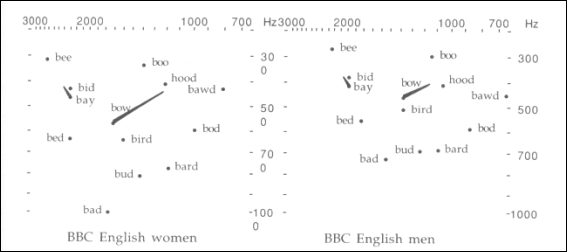
Formant Three 第三共振峰
Formant
three has very little function in distinguishing the vowels. For all
English vowels, the third formant frequency can be predicted fairly
accurately from the frequencies of the first two formants, except the
vowel in most forms of American English bird. The vowel r
has a very low third formant frequency. Its first and second formants are
often very similar to those in hood, but it has a very different
quality.
The
frequency of the third formant is very much affected by the position of
the lips. This makes it important in some languages. It so happens that
neither General American English or BBC English have vowels with the same
tongue positions but different lip positions.
第三共振峰對於母音的辨識並沒有太大功能。大部分英語母音的第三個共振峰都可以由第一及第二個共振峰的頻率推算出來。